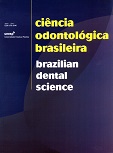Efeito de diferentes tratamentos do substrato dental na resistência adesiva e fixação de restaurações indiretas associada a adesivo auto-condicionante
DOI:
https://doi.org/10.14295/bds.2006.v9i2.502Abstract
RESUMOEste trabalho avaliou a resistência adesiva (μTBS) na fixação de restaurações indiretas por meio de cimento resinoso e adesivo auto-condicionante sob influência de diferentes tratamentos prévios de esmalte e dentina. Trinta incisivos bovinos foram extraídos e tiveram suas raízes cortadas na junção cemento-esmalte. A superfície vestibular dos dentes foi lixada até exposição de dentina superficial, padronizando a formação de smear layer. As amostras foram divididas aleatoriamente em três grupos (n=10): G1: aplicação do adesivo auto-condicionante One up Bond F (OB), seguindo as instruções do fabricante; G2:condicionamento com ácido fosfórico à 37% em esmalte e dentina seguindo aplicação de (OB); G3: jateamento com óxido de alumínio 50μm em esmalte e dentina previamente à aplicação de (OB). Restaurações indiretas com resina composta foram fixadas usando cimento resinoso dual e as amostras foram cortadas com área adesiva de aproximadamente 1,0 mm² em três regiões: esmalte (E), dentina periférica (DP) e dentina central (DC). Foram submetidas a ensaio de microtração em máquina de ensaio mecânico em velocidade de 0,5mm/min. Após fratura, as amostras foram analisadas em Microscopia Eletrônica de Varredura (MEV) para avaliação do padrão de fratura. Os valores de (μTBS) foram expressos em MPa e os dados foram analisados em ANOVA seguido por teste Tukey (p<0,05). Os resultados foram: E/G2: 30,4±11,9a; E/G3: 16,0±8,9b; E/G1: 15,8±5,8b; DP/G1: 24,2±12,1a; DP/G3: 15,2±7,1b; DP/G2: 15,0±9,8b; DC/G1: 17,3±10,4a; DC/G3: 11,6±3,5b; DC/G2: 11,4±5,2b. O jateamento não aumentos os valores de (μTBS). O prévio condicionamento ácido aumentou a resistência adesiva em esmalte e diminuiu em dentina.
Downloads
Downloads
Published
How to Cite
Issue
Section
License
Brazilian Dental Science uses the Creative Commons (CC-BY 4.0) license, thus preserving the integrity of articles in an open access environment. The journal allows the author to retain publishing rights without restrictions.
=================




























